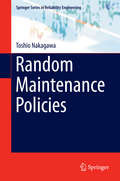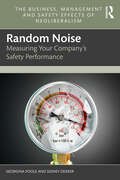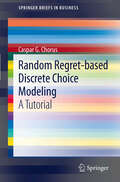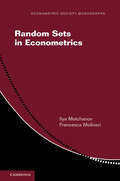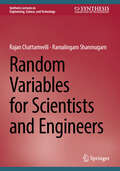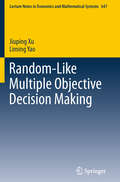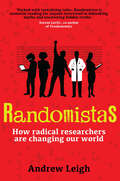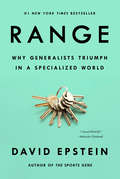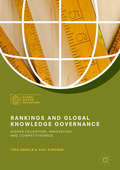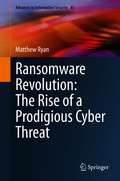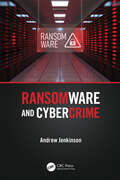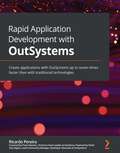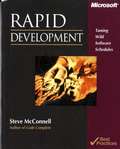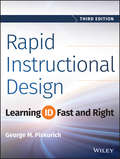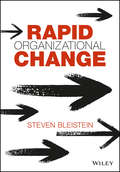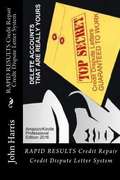- Table View
- List View
Random Maintenance Policies
by Toshio NakagawaExploring random maintenance models, this book provides an introduction to the implementation of random maintenance, and it is one of the first books to be written on this subject. It aims to help readers learn new techniques for applying random policies to actual reliability models, and it provides new theoretical analyses of various models including classical replacement, preventive maintenance and inspection policies. These policies are applied to scheduling problems, backup policies of database systems, maintenance policies of cumulative damage models, and reliability of random redundant systems. Reliability theory is a major concern for engineers and managers, and in light of Japan's recent earthquake, the reliability of large-scale systems has increased in importance. This also highlights the need for a new notion of maintenance and reliability theory, and how this can practically be applied to systems. Providing an essential guide for engineers and managers specializing in reliability maintenance and quality control, this book provides a useful resource for those with doubts carrying out maintenance of new and large systems. It is also intended for graduate students and researchers interested in operations research, statistics, industrial engineering and management science.
Random Noise: Measuring Your Company's Safety Performance (The Business, Management and Safety Effects of Neoliberalism)
by Sidney Dekker Georgina PooleIn the realm of safety management, this book embarks on a profound exploration of how the political economy was reshaped in the last two decades. Much like privatization, deregulation, and financialization altered the economic landscape, this narrative unveils how safety management has been affected by the intertwined dynamics of asset underinvestment, privatization, self-regulation, workplace flexibilization, and market-driven policies.This book, the second installment of a thought-provoking trilogy on the consequences of neoliberalism, mirrors the political economy's promotion of the private sector's role in the economy. Just as neoliberalism amplified and accelerated the mechanisms of human-made disasters in complex systems, this narrative lays bare the heightened potential for safety misfortunes when governed by market-driven principles.As the story unfolds, the book delves into the concept of 'synoptic legibility' in safety management, akin to how the political economy distilled its essence into privatization and deregulation. The authors scrutinize the consequences of translating safety measures into rigid targets, unveiling how this shift can distort the integrity of safety metrics and inadvertently harm individuals. Drawing parallels with historical blunders such as England's window tax, the book contemplates the precarious nature of equating simplified metrics with safety achievements. Much like the political economy's 'acceptable risk' renegotiations, it examines how the pursuit of safety through metrics and surveillance can lead to 'manufactured insecurity,' eroding trust, autonomy, and professionalism.In Random Noise, Poole and Dekker extend this reach once again, writing for all managers, board members, organization leaders, consultants, practitioners, researchers, lecturers, students, and investigators curious to understand the genuine nature of organizational and safety performance.
Random Regret-based Discrete Choice Modeling: A Tutorial
by Caspar G. ChorusThis tutorial presents a hands-on introduction to a new discrete choice modeling approach based on the behavioral notion of regret-minimization. This so-called Random Regret Minimization-approach (RRM) forms a counterpart of the Random Utility Maximization-approach (RUM) to discrete choice modeling, which has for decades dominated the field of choice modeling and adjacent fields such as transportation, marketing and environmental economics. Being as parsimonious as conventional RUM-models and compatible with popular software packages, the RRM-approach provides an alternative and appealing account of choice behavior. Rather than providing highly technical discussions as usually encountered in scholarly journals, this tutorial aims to allow readers to explore the RRM-approach and its potential and limitations hands-on and based on a detailed discussion of examples. This tutorial is written for students, scholars and practitioners who have a basic background in choice modeling in general and RUM-modeling in particular. It has been taken care of that all concepts and results should be clear to readers that do not have an advanced knowledge of econometrics.
Random Sets in Econometrics (Econometric Society Monographs #60)
by Ilya Molchanov Francesca MolinariRandom set theory is a fascinating branch of mathematics that amalgamates techniques from topology, convex geometry, and probability theory. Social scientists routinely conduct empirical work with data and modelling assumptions that reveal a set to which the parameter of interest belongs, but not its exact value. Random set theory provides a coherent mathematical framework to conduct identification analysis and statistical inference in this setting and has become a fundamental tool in econometrics and finance. <P>This is the first book dedicated to the use of the theory in econometrics, written to be accessible for readers without a background in pure mathematics. Molchanov and Molinari define the basics of the theory and illustrate the mathematical concepts by their application in the analysis of econometric models. The book includes sets of exercises to accompany each chapter as well as examples to help readers apply the theory effectively.<P>Remains accessible for the average reader without advanced knowledge in mathematics.<P> Includes examples of applications to some important problems in econometrics, offering a blue-print for how to apply the techniques in different models.<P> Provides sets of exercises to accompany each chapter.
Random Variables for Scientists and Engineers (Synthesis Lectures on Engineering, Science, and Technology)
by Ramalingam Shanmugam Rajan ChattamvelliThis book provides an introductory overview of random variables and their transformations. The authors approach the topic with statistics students in mind, along with researchers in various fields who are interested in data analysis. The book begins with by defining and explaining mathematical expectation. The authors then discuss transformations of random variables, including distribution functions and special functions. The book also covers joint probability distribution and its applications. The authors have updated and expanded upon their writing on these topics, which they originally covered in their previous book, Statistics for Scientists and Engineers.
Random-Like Multiple Objective Decision Making
by Jiuping Xu Liming YaoWhat are the random-like phenomena that can be found everywhere in real-life world? When carrying out a random sampling survey on the traffic situation, we often obtain some descriptive results such as approximately expedite, a little crowded and so on, therefore, the average level should be regarded as the random fuzzy phenomenon, which is one of the random-like phenomena. Decision makers usually need to make the decision for these problems with random-like phenomena. Which model should be constructed for them? How should we handle these models to find the optimal strategy? How can we apply these models to solve real-life problems with random-like phenomena? In order to answer these questions, this book provides an up-to-date methodology system 5MRP for random-like multiple objective decision making, which includes problem system with random-like phenomena, model system with random-like coefficients, research system with random-like uncertain methods. Some practical applications are also provided to illustrate the effectiveness of the proposed methodology system. Researchers, practitioners and students in systems science, economics, mathematics, information, engineering and MS/OR will get a lot of useful references from this research monograph.
Randomistas: How Radical Researchers Are Changing Our World
by Andrew LeighA fascinating account of how radical researchers have used experiments to overturn conventional wisdom and shaped life as we know itExperiments have consistently been used in the hard sciences, but in recent decades social scientists have adopted the practice. Randomized trials have been used to design policies to increase educational attainment, lower crime rates, elevate employment rates, and improve living standards among the poor.This book tells the stories of radical researchers who have used experiments to overturn conventional wisdom. From finding the cure for scurvy to discovering what policies really improve literacy rates, Leigh shows how randomistas have shaped life as we know it. Written in a &“Gladwell-esque&” style, this book provides a fascinating account of key randomized control trial studies from across the globe and the challenges that randomistas have faced in getting their studies accepted and their findings implemented. In telling these stories, Leigh draws out key lessons learned and shows the most effective way to conduct these trials.
Randomly Combine Concepts: Card Games and Sky Rises--How to Generate Intersectional Ideas
by Frans JohanssonIntersectional ideas consist of concepts from different fields. How do these combinations occur, and what is the secret behind an idea that really makes it big? This chapter looks at these questions and the story of a young mathematician who manages to take the gaming world by storm.
Randomness and Elements of Decision Theory Applied to Signals
by Monica Borda Romulus Terebes Raul Malutan Ioana Ilea Mihaela Cislariu Andreia Miclea Stefania BarburiceanuThis book offers an overview on the main modern important topics in random variables, random processes, and decision theory for solving real-world problems. After an introduction to concepts of statistics and signals, the book introduces many essential applications to signal processing like denoising, texture classification, histogram equalization, deep learning, or feature extraction. The book uses MATLAB algorithms to demonstrate the implementation of the theory to real systems. This makes the contents of the book relevant to students and professionals who need a quick introduction but practical introduction how to deal with random signals and processes
Range: Why Generalists Triumph in a Specialized World
by David EpsteinA powerful argument for how to succeed in any field: develop broad interests and skills while everyone around you is rushing to specialize. Plenty of experts argue that anyone who wants to develop a skill, play an instrument, or lead their field should start early, focus intensely, and rack up as many hours of deliberate practice as possible. If you dabble or delay, you’ll never catch up to the people who got a head start. But a closer look at research on the world’s top performers, from professional athletes to Nobel laureates, shows that early specialization is the exception, not the rule. <P><P>David Epstein examined the world’s most successful athletes, artists, musicians, inventors, forecasters and scientists. He discovered that in most fields—especially those that are complex and unpredictable—generalists, not specialists, are primed to excel. Generalists often find their path late, and they juggle many interests rather than focusing on one. They’re also more creative, more agile, and able to make connections their more specialized peers can’t see. <P><P>Provocative, rigorous, and engrossing, Range makes a compelling case for actively cultivating inefficiency. Failing a test is the best way to learn. Frequent quitters end up with the most fulfilling careers. The most impactful inventors cross domains rather than deepening their knowledge in a single area. As experts silo themselves further while computers master more of the skills once reserved for highly focused humans, people who think broadly and embrace diverse experiences and perspectives will increasingly thrive. <P><b>A New York Times Bestseller</b>
Rangeland Ecology And Management
by Harold Heady R. Dennis ChildOver the last two decades the science of range management, like many other resource disciplines, has embraced and integrated environmental concerns in the field, the laboratory, and policy. Rangeland Ecology and Management now brings this integrated approach to the classroom in a thoroughly researched, comprehensive, and readable text. The authors discuss the basics of rangeland management--including grazing and practical management of animals and vegetation--and place those basics within the context of decision making for damaged land, riparian and water conservation, multiple use, and modeling. Concepts such as succession, stability, and range condition are examined and their effects discussed. Fire is considered as an environmental factor. Appendixes provide scientific and common names of range plants and animals. These and many other issues crucial to the understanding of successful range management combine to make the finest text for upper-level undergraduates now available.
Ranking the World
by Jack Snyder Alexander Cooley Cooley, Alexander and Snyder, JackOver the last decade, international rankings have emerged as a critical tool used by international actors engaged in global governance. State practices and performance are now judged by a number of high-profile indices, including assessments of their levels of corruption, quality of democracy, creditworthiness, media freedom, and business environment. However, these rankings always carry value judgments, methodological choices, and implicit political agendas. This volume expertly addresses the important analytical, normative, and policy issues associated with the contemporary practice of 'grading states'. The chapters explore how rankings affect our perceptions of state performance, how states react to being ranked, why some rankings exert more global influence than others, and how states have come to strategize and respond to these public judgments. The book also critically examines how treating state rankings like popular consumer choice indices may actually lead policymakers to internalize questionable normative assumptions and lead to poorer, not improved, public policy outcomes.
Rankings and Decisions in Engineering: Conceptual and Practical Insights (International Series in Operations Research & Management Science #319)
by Fiorenzo Franceschini Luca Mastrogiacomo Domenico A. MaisanoThis book focuses on decision-making problems in engineering. It investigates the ranking aggregation problem and the related features, such as input/output data, simplification hypotheses, importance hierarchy of experts. In addition to a well-structured overview of several interesting, consolidated methodological approaches, it presents innovative approaches that can also be applied profitably in other fields. The fascinating selection of topics included is based on research that has been developed in the past twenty years. The descriptions are supported by figures, tables, flowcharts, diagrams, examples and practical case studies. The book is an ideal resource for engineering academics, practitioners, technicians and students, who do not necessarily have an in-depth knowledge of decision-making. It is also a thought-provoking read for engineers and academics looking for innovative ways to improve engineering processes in a variety of fields, such as conceptual design, quality improvement, reliability engineering. “Today, rankings are exercised in all spheres of life, products are ranked on Amazon and similar platforms; services such as restaurants and hotels on platforms such as TripAdvisor; and other services such as lectures or even medical treatment on different specialized platforms. We often make our daily decisions based on these rankings. The quality of our decisions depends on our ability to select appropriate methods to fit the context and needs. We need to be familiar with the theory and practice of these methods to make them useful. To this purpose, this book is an important addition to the bookshelves of academics and professionals, not only from engineering. The connection between theory and practice is weaved throughout the book, making it useful for practitioners also.” Prof. Yoram Reich, Full Professor and Head of Systems Engineering research Initiative at Tel Aviv University (Israel), Editor-in-Chief of “Research in Engineering Design”
Rankings and Global Knowledge Governance: Higher Education, Innovation and Competitiveness (Palgrave Studies in Global Higher Education)
by Tero Erkkilä Ossi PiironenHigher education and innovation policies are today seen as central elements in national economic competitiveness, increasingly measured by global rankings. The book analyses the evolution of indicator-based global knowledge governance, where various national attributes have been evaluated under international comparative assessment. Reflecting this general trend, the Shanghai ranking, first published in 2003, has pressured governments and universities all over the world to improve their performance in global competition. More recently, as global rankings have met criticism for their methodology and scope, measurements of various sizes and shapes have proliferated: some celebrating novel methodological solutions, others breaking new conceptual grounds. This book takes a fresh look at developments in the field of knowledge governance by showing how emerging indicators, innovation indexes and subnational comparisons are woven into the existing fabric of measurements that govern our ideas of higher education, innovation and competitiveness. This book argues that while rankings are becoming more numerous and fragmented, the new knowledge products, nevertheless, tend to reproduce ideas and practices existing in the field of global measurement.
Ransomware Revolution: The Rise of a Prodigious Cyber Threat (Advances in Information Security #85)
by Matthew RyanThis book explores the genesis of ransomware and how the parallel emergence of encryption technologies has elevated ransomware to become the most prodigious cyber threat that enterprises are confronting. It also investigates the driving forces behind what has been dubbed the ‘ransomware revolution’ after a series of major attacks beginning in 2013, and how the advent of cryptocurrencies provided the catalyst for the development and increased profitability of ransomware, sparking a phenomenal rise in the number and complexity of ransomware attacks. This book analyzes why the speed of technology adoption has been a fundamental factor in the continued success of financially motivated cybercrime, and how the ease of public access to advanced encryption techniques has allowed malicious actors to continue to operate with increased anonymity across the internet. This anonymity has enabled increased collaboration between attackers, which has aided the development of new ransomware attacks, and led to an increasing level of technical complexity in ransomware attacks. This book highlights that the continuous expansion and early adoption of emerging technologies may be beyond the capacity of conventional risk managers and risk management frameworks.Researchers and advanced level students studying or working in computer science, business or criminology will find this book useful as a reference or secondary text. Professionals working in cybersecurity, cryptography, information technology, financial crime (and other related topics) will also welcome this book as a reference.
Ransomware and Cybercrime
by Andrew JenkinsonIn May 2021, Jim Gosler, known as the Godfather and commander of US agencies’ cyber offensive capability, said, ''Either the Intelligence Community (IC) would grow and adapt, or the Internet would eat us alive.'' Mr Gosler was speaking at his retirement only several months before the terrorist attacks of 9/11. He possibly did not realise the catalyst or the tsunami that he and his tens of thousands of US IC offensive website operatives had created and commenced. Over the last two decades, what Mr Gosler and his army of Internet keyboard warriors created would become the modus operandi for every faceless, nameless, state-sponsored or individual cybercriminal to replicate against an unwary, ill-protected, and ignorant group of executives and security professionals who knew little to nothing about the clandestine methods of infiltration and weaponisation of the Internet that the US and UK agencies led, all in the name of security. This book covers many cyber and ransomware attacks and events, including how we have gotten to the point of massive digital utilisation, particularly during the global lockdown and COVID-19 pandemic, to online spending that will see twice the monetary amount lost to cybercrime than what is spent online. There is little to no attribution, and with the IC themselves suffering cyberattacks, they are all blamed on being sophisticated ones, of course. We are witnessing the undermining of our entire way of life, our economies, and even our liberties. The IC has lots to answer for and unequivocally created the disastrous situation we are currently in. They currently have little to no answer. We need—no, we must demand—change. That change must start by ensuring the Internet and all connections to it are secure and no longer allow easy access and exfiltration for both the ICs and cybercriminals.
Rapid Application Development with OutSystems: Create applications with OutSystems up to seven times faster than with traditional technologies
by Ricardo Pereira Paulo Moreira Taiji HaginoDiscover best practices to create simple, robust, and scalable software solutions quickly and securely, and focus on what's important - the business and the end customerKey FeaturesDiscover strategies and tips for low-code and no-code development with the help of useful examplesBuild enterprise-scale reactive web and mobile applicationsExplore the benefits of low-code developmentBook DescriptionOutSystems is a software development platform that speeds up the build phase by abstracting code and making almost everything visual. This means replacing textual language with visual artifacts that avoid lexical errors and speed up code composition using accelerators and predefined templates.The book begins by walking you through the fundamentals of the technology, along with a general overview of end-to-end web and mobile software development. You'll learn how to configure your personal area in the cloud and use the OutSystems IDE to connect with it. The book then shows you how to build a web application based on the best architectural and developmental practices in the market, and takes the same approach for the mobile paradigm. As you advance, you'll find out how to develop the same application, and the great potential of reusing code from one paradigm in another and the symbiosis between them is showcased.The only application that'll differ from the application in the exercise is the one used in business process technology (BPT), with a focus on a common market use case.By the end of this OutSystems book, you'll be able to develop enterprise-level applications on the web and mobile, integrating them with third parties and other systems on the market. You'll also understand the concepts of performance, security, and software construction and be able to apply them effectively.What you will learnGet to grips with the OutSystems infrastructureDevelop reactive web and mobile applications in OutSystems using best practices in Service StudioDefine and design Architecture Canvas (3-Layer Canvas) for your applicationsIntegrate with external systems in OutSystemsEnhance applications with BPTManage and monitor your applications in the OutSystems infrastructureWho this book is forThis book is for back-end developers, tech leaders, UX/UI developers, frontend developers, (in general, full-stack developers), tech companies, and enterprises looking to learn how to develop web and mobile software quickly and disruptively by leveraging OutSystems, one of the most low-code platforms in the market. An IT background is not mandatory; however, experience in SQL, JavaScript, HTML, CSS, and C# is required to get started with this book.
Rapid Credit Growth in Central and Eastern Europe
by Nci Ötker-Robe Charles EnochThis book represents the latest developments and policy debate on a very current issue: the rapid growth of banking sector credit to the private sector, which continues to occupy the minds of academics and policymakers alike in many Central and Eastern European (CEE) countries. The contributions, from the representatives of international organizations and monetary and supervisory authorities of a number of Western and CEE countries, discuss ways to assess and respond to excessive credit growth. Case studies represent the challenges faced by policymakers in dealing with rapid credit growth, providing useful lessons for other countries experiencing a similar phenomenon.
Rapid Current Account Adjustments: Are Microstates Different?
by Patrick ImamA report from the International Monetary Fund.
Rapid Development
by Steve McconnellCorporate and commercial software-development teams all want solutions for one important problem--how to get their high-pressure development schedules under control. In RAPID DEVELOPMENT, author Steve McConnell addresses that concern head-on with overall strategies, specific best practices, and valuable tips that help shrink and control development schedules and keep projects moving. Inside, you'll find: A rapid-development strategy that can be applied to any project and the best practices to make that strategy work Candid discussions of great and not-so-great rapid-development practices--estimation, prototyping, forced overtime, motivation, teamwork, rapid-development languages, risk management, and many othersA list of classic mistakes to avoid for rapid-development projects, including creeping requirements, shortchanged quality, and silver-bullet syndromeCase studies that vividly illustrate what can go wrong, what can go right, and how to tell which direction your project is goingRAPID DEVELOPMENT is the real-world guide to more efficient applications development.
Rapid Development: Taming Wild Software Schedules
by Steve M. McconnellGet your development schedules under control and on track! Corporate and commercial software-development teams all want solutions for one important problem--how to get their high-pressure development schedules under control.
Rapid Growth, Done Right: Lead, Influence and Innovate for Success
by Val WrightCorporations that prioritize innovation have three things in common: they are successful organizations who deliver consistent growth; they pay attention to the relationship between their technical, creative and business minds; they are well managed companies whose leader makes informed decisions and inspires both colleagues and customers. In Rapid Growth, Done Right, Val Wright explains how an inspirational CEO is the pivotal power in any organization. They need to lead and inspire in the right way, creating a team with complementary talents that circle the CEO so that business growth becomes effortless. The leader who influences and innovates successfully will orchestrate an organization that helps everyone dream big but stay grounded, rapidly taking ideas and putting them into action. Using examples from a number of leading corporations, and featuring interviews with C-suite executives at some of the word's most innovative businesses, Rapid Growth, Done Right is an essential guide to to creating products and services that customers will love while delivering consistent growth.
Rapid Instructional Design
by George M. PiskurichThis is the second edition of the best-selling book that shows how to get instructional design done fast and get it done right! If you need a basic understanding of what instructional design is and a hands-on, to-the-point method of ensuring that the training and performance interventions you put into place meet the needs of your staff and your organization, this book is for you. It offers a no-nonsense walk through all the steps in the instructional design process and each step is explained in language that is conversational and easy to understand. This new edition addresses such topics as learning analysis, return on investment, and designing asynchronous and synchronous e-learning, as well as a wealth of illustrative examples of storyboards and professional commentary and case studies from professionals in the field.
Rapid Organizational Change
by Steven BleisteinA new lean and agile model for more effective change management Rapid Organizational Change gets right to the heart of the change initiative problem, and offers a time- and money-saving solution. The fact that so many change initiatives fail or underperform can be traced back to one major issue: pace. While most change management models stress the importance of timeliness, they remain bound to an organization-wide approach to execution.. By targeting change efforts at specific mid-level layers of management, this book helps you achieve the desired outcome more efficiently while saving time, effort and money. Full of practical advice and real-world examples, this book is your action guide to making change happen in a meaningful way. You'll learn how to continually develop great leadership at the institutional level, and gain real, actionable guidance on putting more women in management positions to help you grab that competitive advantage. Today's disruptive technologies and macro-economic patterns have elevated organizational agility to the rank of survival skill. Change is a constant in business, but it's now coming faster than ever; this book gives you the strategies you need to keep from being left behind. Target mid-level managers for faster change Institute perpetual leadership development outside of HR Correct gender inequality in management positions Utilize your best resources to gain competitive advantage Most change management models have the same inherent problem: by the time new processes and strategies trickle down to every manager and staff member, the opportunity has passed and the change can no longer be effective for its intended purpose. Rapid Organizational Change lays out a new shortcut to help your organization stay out in front.
Rapid Results Credit Repair Credit Dispute Letter System
by John Harris<p>Even though your credit affects your whole life experience you probably know very little about real credit repair. Most of the books I have read online about credit repair are out of date or more often than not don't really have a clue what is going on. Let's face it all are lives are on a clock that is always ticking. Tick Tock Tick Tock. THIS IS NOT A PRACTICE RUN. This is your one life. Every day with bad credit is a day you are not experiencing your full life experience. <p>Imagine knowing you have great credit. You know when you talk to the guy in the suit that you have great credit. You know you will be approved for anything. You can shop around for the best rates. You have the best property and pay less than the guy with the dumpy property. You drive the best car for less than the poor guy driving the seven-year-old vehicle. You might start flipping property. You might buy a business on credit. People respect you because you are the baller, you can get things done because you have access to CREDIT. You can take advantage of great deals because you have CREDIT. <p>My bet is that you know more about cooking a turkey, changing your oil, what's on Netflix, Geography, Donald Trump, Words of a different language, Facebook, etc. THAN YOU DO ABOUT REAL CREDIT REPAIR. vI guarantee you can have good credit</p>
